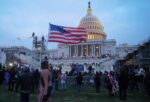Capitol assault: the real reason Trump and the crowd almost killed US democracy
Stephen ReicherBishop Wardlaw Professor in the School of Psychology & Neuroscience, University of St Andrews Alex HaslamProfessor of Psychology and ARC Laureate Fellow, The University of Queensland Evangelos NtontisLecturer in Psychology, The Open University Klara JurstakovaPhD Candidate, Canterbury Christ Church University It was the moment that could have brought US democracy to its knees. One year ago, around noon on January 6, 2021, Donald Trump gave the concluding speech to a “Stop the Steal” rally in Washington DC. Within an hour, protesters attacked and then breached barricades around the Capitol Building, seat of the US Congress. By 1.30pm, they had invaded the building itself. And by the time they left, five people had died. To what extent were the two events related? Did Trump’s words incite his followers to assault the Capitol? Or did the rioters act independently and of their own accord? These were the questions on which Trump’s second impeachment trial turned. More specifically, the debate centred on whether Trump’s words contained clear instructions that guided what happened next, with special attention given to a specific sentence in the speech: If you don’t fight like hell, you’re not going to have a country anymore. For the prosecution, this was the smoking gun. For the defence, the word “fight” was a mere metaphor, akin to “fighting for one’s principles”. To quote from the opening statement of Trump’s lawyer, Michael van der Veen: This is ordinary political rhetoric that is virtually indistinguishable from the language that has been used across the political spectrum for hundreds of years. In the end, interpretation split clearly along party lines. In the Senate, 48 Democrats voted for impeachment, none against, while 43 Republicans voted against impeachment and seven for. The total in favour failed to reach the two-thirds threshold, so Trump was acquitted as not guilty. But whatever one […]










